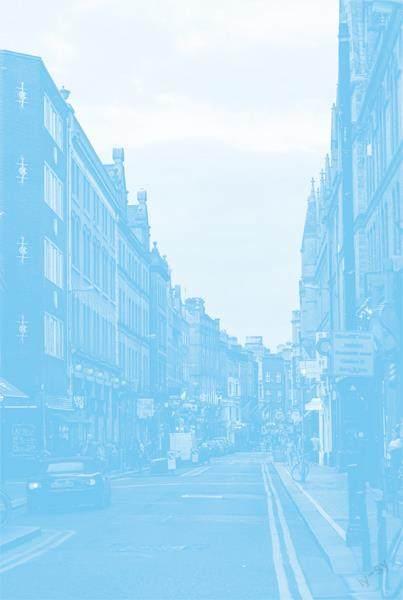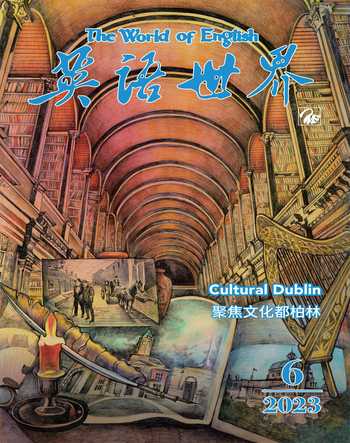On the Street (Excerpt)街上(节选)
约翰·班维尔 赵喜梅/译介

【导读】约翰·班维尔(1945— ),爱尔兰小说家、编剧、戏剧改编作家、电影剧本作家,其小说《证词》(The Book of Evidence)曾入围布克奖提名,2005年凭借第14部小说《海》(The Sea)获得布克獎。他还斩获不少其他重要奖项,包括卡夫卡奖(2011)、爱尔兰笔会奖(2013)、澳大利亚国家文学奖(2013)、奥地利王子奖(2014)等。他曾以本杰明·布莱克(Benjamin Black)为笔名,创作了主角为奎尔克(Quirke)的犯罪小说系列。2007年,班维尔入选英国皇家文学学会。“街上”节选自班维尔的散文集《光阴拾碎——都柏林回忆录》(Time Pieces: A Dublin Memoir,2016)第四章。人的记忆不一定是连贯的,往往以碎片形式嵌于我们的脑中。那些可捡拾的记忆片段,是随着时间逐渐深刻的人生经验;我们年轻时错过不少“熟视之若无睹也”的事物,所幸,岁月会赋予我们辩识真善美的智慧,那些险些被记忆抛却的终将会被捡起。本文作者对乔治王朝风格的都柏林的情感可谓后知后觉,他带着一半遗憾与一半幸运为读者当向导,走街穿巷,让我们领略这座城市的前世今生。
I could not have lived in a lovelier location. The view from the Natural History Museum along Merrion Square and Mount Street to St Stephens Church—the Pepper Canister, as it is fondly called—is one of the most handsome and dignified prospects in any of the worlds cities that I know or have visited. Leinster, originally Kildare, House, which is now the seat of government, was built in the 1740s by the Earl of Kildare, James FitzGerald, in an unfavoured and marshy area south of the river Liffey. Poor though the site might be, the canny earl predicted that fashion would soon follow him, and he was right: before the end of the century the bulk of the citys aristocracy had moved southwards across the river. The result was that in the following century, rich redoubts such as Henrietta Street and Rutland Square would fall into decrepitude and be sold off to rack-renting landlords, so that much of the north inner city was transformed into one of the worst slums in Europe. Meanwhile, on the south side of the river there grew up around Leinster House a grid of elegant streets and boulevards, a large number of which are still intact and in use today, though most of the fine old houses have been given over to office space.
我不可能住到比这儿还好的地方了。从自然历史博物馆沿梅里恩广场和芒特街往前,直至圣斯蒂芬大教堂——即人们戏称的胡椒罐教堂——这一带,在我所知道的或造访过的世界任何城市里,都是风景绝佳的。伦斯特(旧称基尔代尔)府,现今的政府所在,建于18世纪40年代,创建人为基尔代尔伯爵詹姆斯·菲茨杰拉德。府邸地处利菲河以南没人喜欢的沼泽区。尽管选址可能不很理想,老谋深算的伯爵预言,他将引领潮流——他还真说对了:18世纪末,大批城市贵族南迁至河对岸。结果,随后的一个世纪,亨丽埃塔街和拉特兰广场等富人庇护所将逐渐败落,被售予赚取高额租银的房东;如此,北部内城的大部分地区便沦为欧洲最糟糕的贫民窟。与此同时,河南的伦斯特府周边有了纵横交错的雅致街巷和林荫大道,现今好多仍然完好如初,照旧发挥作用,只不过精美的老宅大多变成了办公场所。
A lot of the Georgian city was still standing when I first came to live there, but a lot of it was gone, too. It is a fact, as Maurice Craig pointed out as recently as 1992, that ‘much more of Dublin survives, and in reasonable order, than might be deduced from listening to the lamentations of those who deplore its destruction, but all the same, in the postwar years and up to the end of the 1960s, the city was subjected to appalling bouts of officially sanctioned destruction. The ultra-nationalist ideologues who ran the country then had scant regard for the delights of Georgian architecture, and indeed many of them would have seen Georgian Dublin as a despised monument to our British conquerors, who had been driven out in the War of Independence at the start of the 1920s. Hence permissions were liberally given for large-scale despoliation of, in Yeatss words, ‘many ingenious lovely things. A particularly deplorable instance of urban mutilation was the demolition of a large stretch of the south side of Fitzwilliam Street, to make way for the building of the Electricity Supply Boards headquarters—one of the developments that Daithí Hanly had so passionately opposed. Had the state coffers been in a more healthy state, it is likely that many other such streets would have been razed to make way for the New Brutalism. There was even a plan to fill in the Grand and Royal Canals and build super-roads over them, with sewers underneath. And the bosky green heart of delightful Merrion Square, which was then the property of the Catholic Church, barely escaped having a monster cathedral erected on it, at the behest of the unspeakable Archbishop McQuaid.
我初到此處,这座乔治王朝风格的城市还保留着许许多多旧时的风物,不过丢失的也不少。事实上,如莫里斯·克雷格1992年指出的那样,“听到那些痛恨拆除者的哀叹,可能会以为都柏林没剩什么了,其实都柏林保留下来的东西要多得多,并且井然有序”;尽管如此,战后及至20世纪60年代末,这座城市经历了数次骇人的官方拆毁。那个时候,极端民族主义意识形态拥护者掌控国家,蔑视乔治王朝风格建筑的趣味,实际上,他们中的很多人将乔治王朝风格的都柏林视为我们英国征服者可耻的历史见证,尽管20世纪20年代初的独立战争早已驱赶了征服者。因此,就有了大规模的自由掠夺令,掠夺叶芝所说的“许许多多巧夺天工的美好事物”。有一起城市破坏案例尤令人震惊,即菲茨威廉街南边的大片拆毁,为的是腾出地方修建供电局总部——这是达西·汉利极力反对的开发项目之一。倘若市府财政有更多结余,很可能其他更多类似的街道会被夷为平地,助长建筑的新粗野主义。甚至还有一个计划要填平大运河和皇家运河,上建高速公路,下修排水系统。美丽的梅里恩广场那时隶属天主教会,广场中心地带林木繁茂,也差点未能逃脱建一座丑陋教堂的命运,那曾是臭名昭著的大主教麦奎德的要求。
In 1969, Green Property—my Mount Street landlords, as it happened—a development company with strong links to the ruling Fianna Fáil party, were given permission by the then Minister for Local Government to knock down a large chunk of Hume Street, another fine example of Georgian architecture, that leads from Ely Place on to St Stephens Green. When the plan became public, the buildings were promptly occupied by a band of architectural students, who in time were joined by a number of public figures, including Garret FitzGerald, a Member of Parliament who would later become Taoiseach, and the future President of Ireland, Mary Robinson. However, late one night Green Property sent in a demolition crew, who destroyed the roofs and much of the interiors of the houses. In the end the company was compelled to erect fake Georgian buildings on the spot—‘unconvincing paraphrases masquerading as replicas, in Maurice Craigs disdainful judgement—while the rest of the street was saved.
1969年,绿色物业——恰巧为本人的芒特街房东——一家与爱尔兰共和党有着牢靠关系的开发公司,经当时的地方政府部部长批准,拆除了休姆街相当大的一片建筑,这里由伊利广场直通圣斯蒂芬绿地,为乔治王朝风格建筑的另一优秀范例。拆除计划一经公布,这里旋即为一批建筑系的学生占领,许多公众人物紧接着也加入其中,包括后来成为爱尔兰总理的国会议员加勒特·菲茨杰拉德和未来的爱尔兰总统玛丽·罗宾逊。然而,一天深夜,绿色物业派来拆迁组,掀翻了屋顶,房子内部破坏得也十分严重。最终,该公司被责令于原址仿建乔治王朝风格的建筑——莫里斯·克雷格对这种做法很是嗤之以鼻,他评价道:“不能令人信服的套用,权且乔装为复制品。”——所幸街上的其他部分被保存下来。
Strangely, perhaps, none of this seems to have had much effect on me. The truth is, I had little interest in Dublins past, and not much in its present, either, if it came to that. What was it to me that in its days of glory Dublin had been the second city of the British Empire—‘the finest classical city in Europe, according to the architectural historian Mark Girouard—or that it was unique in having two major canals, or that the Duke of Wellington had been born in Merrion Street opposite what is now the Department of the Taoiseach? For me, as a writer in the making, the fact was that Joyce had seized upon the city for his own literary purposes and in doing so had used it up, as surely as Kafka did with the letter K, and consequently the place was of no use to me as a backdrop for my fiction. True, some of my early short stories take place in an identifiable Dublin, but they could as well have been set in London, or Paris—or Moscow, for that matter. It was not until much later, when I invented my dark brother Benjamin Black, that I saw the potential of 1950s Dublin as a setting for his noir novels.
或许有些奇怪,这些历史事件并未对我造成太大的影响。事实是,我并不太在意都柏林的过去,对它的现在也没那么感兴趣,如果一定得谈现在的话。都柏林辉煌时曾是大英帝国的第二大城市——按照建筑历史学家马克·吉鲁阿尔的说法,都柏林是“欧洲最好的古典城市”——或者,它因拥有两条大运河而得天独厚,又或者,惠灵顿公爵就出生在如今爱尔兰总理府对面的梅里恩街上——而这些对我有什么意义呢?于我,一个成长中的作家,我知道的是,乔伊斯为了自己的文学旨趣使这个城市为他所用,直至利用殆尽,就像卡夫卡对字母K的使用那样,因此,都柏林这个地方在我的小说写作中用作背景也没什么意义了。没错,我早期的一些短篇故事看得出来发生在都柏林,但它们也可以发生于伦敦或巴黎或莫斯科。直到很久以后,当我以虚构的神秘老兄本杰明·布莱克之名开始创作,我才发现可以将20世纪50年代的都柏林作为其名下黑色悬疑小说的背景。
Thus in this wise I largely ignored Dublin, as I had largely ignored Wexford. Again, I seek to comfort and perhaps even exonerate myself with the thought that this is what artists do, the imagination being their only true place in which richly to live. But am I convinced? Some years ago I was asked to contribute to a collection of six-word ‘stories, along the lines of Hemingways masterpiece—one of the best things he ever wrote: ‘For sale: baby shoes, never worn. My contribution to the volume may seem facetious, but it contains a serious and bitter truth: ‘Should have lived more, written less.
就這样,我大致上忽略了都柏林,就如我极大地忽略了韦克斯福德郡那样。又一次,我试着以艺术家就该如此来自我安慰,甚至自我开脱,以为想象是艺术家可以充实生活的唯一真实所在。可是,我被说服了吗?若干年前,我应邀撰写一个六字“故事”集,类似海明威的杰作——他曾写过的最好的作品之一:“售:婴儿鞋,全新。”我的投稿或许显得滑稽,但包含一个严肃且痛苦的事实:“本该多活、少写。”
Yet I was happy in those early years, after my aunt died and I took over her ninety-nine-year lease on the Mount Street flat—happier, indeed, than I realised at the time. And how I loved my particular patch of Dublin. I recognise now that for all my cosmopolitan as-pirations, mine was essentially a small-town sensibility, and that Baggotonia was my ideal Wexford-sized vicinity, beyond the borders of which I ventured with reluctance. Thus I remained disgracefully ignorant of, for instance, the medieval quarters of the city, around Swifts St Patricks Cathedral and Guinnesss brewery, or, on the north side, the even older village of Howth and environs—although eventually I was to settle there, in the days when it was still a thriving fishing village; I recall taking my two young sons for walks along the west pier and seeing fishermen in wooden clogs packing kegs of salted herring for export to Britain and Scandinavia; those scenes hang in my memory, colourful and busy and antiquated, like genre pieces by one of the minor Dutch masters.
不过,姑妈去世后我接手了她在芒特街99年租期的公寓,最初几年我过得很快乐——事实上,比我那时意识到的还要快乐。我是那么热爱为我专用的那一小块都柏林。如今我认识到,尽管我有世界主义的都市理想,但本质上我具有的就是小城情感,巴格特奥尼亚是我理想中同韦克斯福德那般大小的地区,这个区域外的地方我是不大乐意去冒险的。因此,非常惭愧,我对这个城市的中世纪风格建筑区了解甚少,比如斯威夫特担任过牧师的圣帕特里克大教堂和吉尼斯啤酒厂周边,或者北边年代更久的霍斯村及附近地区——尽管我最后于此定居,那个时候它还是一个正在发展的渔村。犹记得带两个年幼的儿子沿西堤散步,看见穿着木屐的渔夫们一桶桶地装着出口英国和斯堪的纳维亚的咸鲱鱼;那些情景经常在我脑中萦回,多彩、繁忙而古旧,像某个不知名的荷兰画师笔下的浮世绘碎片。
Of the suburbs I knew nothing at all, and recoiled from the prospect of all those acres of housing estates and soot-blackened factories, dotted here and there with littered patches of green where Traveller children galloped bareback on piebald ponies, and where in my overheated imagination of such places wild-eyed young men with Brylcreemed hair engaged in gang warfare, and wives were beaten and girls were got in the family way, and at night the barn-sized pubs throbbed with a drunken din, and life in general was irredeemably squalid.
关于都柏林的城郊,我压根儿一无所知,想象中的情景令我却步:成片的住宅区和煤烟熏黑的工厂,绿地上随处可见垃圾堆放,游牧民儿童骑在无鞍的花斑小马上飞奔;在我的想入非非中,那样的地方,抹了百利发蜡的不安分的年轻人忙着打群架,妻子老挨打,女孩们未婚先孕,夜间谷仓大的酒吧里充斥着酒醉的喧闹声,总之,那里的生活肮脏污秽得不可救药。
What a prissy and purblind young man I was, a snob with nothing to be snobbish about.
我曾是一个那么刻板拘谨、迟钝愚笨的小子,一个不知凭什么自命不凡的势利鬼。
(译者单位:北京科技大学外国语学院)

